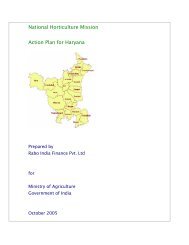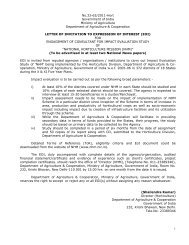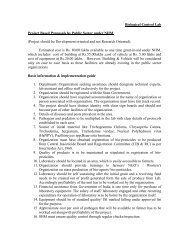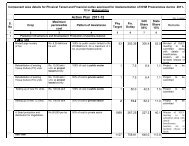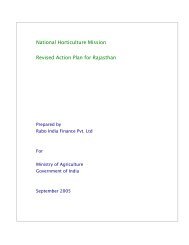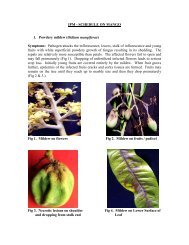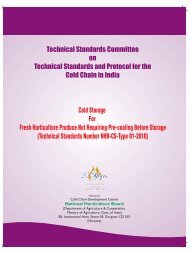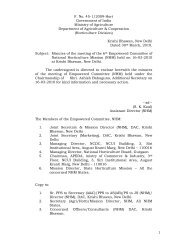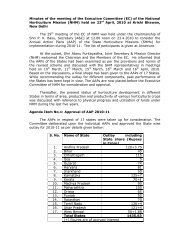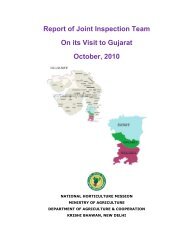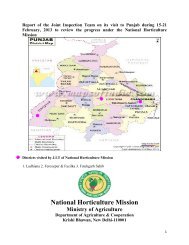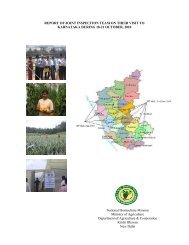IPM SCHEDULE FOR AONLA PESTS National Horticulture Mission
IPM SCHEDULE FOR AONLA PESTS National Horticulture Mission
IPM SCHEDULE FOR AONLA PESTS National Horticulture Mission
You also want an ePaper? Increase the reach of your titles
YUMPU automatically turns print PDFs into web optimized ePapers that Google loves.
Extension Bulletin No. 5<br />
<strong>IPM</strong> <strong>SCHEDULE</strong> <strong>FOR</strong> <strong>AONLA</strong> <strong>PESTS</strong><br />
<strong>Horticulture</strong> Year, 2012<br />
<strong>National</strong> <strong>Horticulture</strong> <strong>Mission</strong><br />
Ministry of Agriculture<br />
Department of Agriculture & Cooperation<br />
Krishi Bhawan, New Delhi-110001
DR. OM PRAKASH<br />
CHIEF CONSULTANT (NHM)<br />
E-MAIL: dromprakash__2004@rediffmail.com<br />
Phone: 011-23382749, (M) 09650175078, 09415111079
<strong>IPM</strong> <strong>SCHEDULE</strong> <strong>FOR</strong> <strong>AONLA</strong> <strong>PESTS</strong><br />
Contents<br />
A. Disease Page<br />
B. Insects<br />
1. Rust 1-2<br />
2. Wilt 2<br />
3. Sooty mould 2-3<br />
4. Lichens 3-4<br />
5. Blue mould 4-5<br />
6. Anthracnose 5-6<br />
7. Soft rot 6<br />
8. Black soft rot 7<br />
9. Phoma rot 7<br />
10. Fruit rot 8<br />
11. Fruit rot 8<br />
12. Fruit rot 8-9<br />
13. Internal Necrosis 9<br />
14. Bark eating caterpillar 10<br />
15. Shoot gall maker 10-11<br />
16. Pomegranate butterfly 11-12<br />
17. Mealy bug 12<br />
18. Aphid 12-13<br />
19. Leaf rollers 13- 14<br />
20. Stone borer 14<br />
21. Fruit midge 14-15
A. DISEASES<br />
<strong>IPM</strong> <strong>SCHEDULE</strong> <strong>FOR</strong> <strong>AONLA</strong> <strong>PESTS</strong><br />
1. Rust (Ravenelia emblicae Styd, Phakopsora phyllanthi Diet)<br />
Symptoms<br />
Disease is responsible for considerable losses in major aonla growing area of<br />
Uttar Pradesh. On fruits initially few black pustules appear which later develop in a ring.<br />
The pustules join together and cover big area of the fruit. On leaves, pinkish brown<br />
pustules develop which may be arranged in group or scattered as infection of fruit does<br />
not go on leaves and vice-versa.(Fig 1 & 2). Teleospores of Ravenelia emblicae causes<br />
the fruit and leaf infection.<br />
Fig. 1 Rust on fruits<br />
Fig 2. Rust on leaves
Management<br />
Three sprays of wettable sulphur (0.4%) of Dithane- Z-78 (0.2%) during July-<br />
September.<br />
Cultivars Banarasi and Chakaiya are believed to be relatively free from disease.<br />
2. Wilt / (Frost injury)<br />
Symptoms<br />
Large number of plants shows cracking, bark splitting, defoliation and wilting symptoms.<br />
The main reason for wilting though was attributed due to frost injury, but association of<br />
Fusarium sp. was also found.<br />
As frost injury predisposes plants to fungal infection, proper protection from frost is<br />
required. (Fig 3 & 4)<br />
Fig. 3 Wilted remnant part of aonla tree Fig 4. Bark cracking and splitting in<br />
wilting plants<br />
Management<br />
During winter (November to January) young plants should be covered during<br />
frost period with sufficient irrigation which protects plants from the frost injury.<br />
Mulching with available organic waste/black polythene.<br />
Cow dung pasting on tree trunk have been found quite effective in minimizing the<br />
frost injury.<br />
3. Sooty mould (Capnodium sp.)<br />
Symptoms<br />
Sooty mould causes velvety covering of black fungal growth on the surface of leaves,<br />
twigs and flower. These are restricted only to the surface and do not penetrate into<br />
leaves (Fig 5).
Fig 5. Sooty mould infection on leaves<br />
Management<br />
Spray starch @2%, lambda cyhalothrin @0.05% and wettable sulphur @0.2% can<br />
be mixed in starch if infection is more.<br />
4. Lichen: [Strigula elegans (Fee.) Mull. Arg.]<br />
Lichens are found on the surface of trunk of the grown up trees. It is seen in the<br />
form of whitish, pinkish, superficial patches of different shapes on the main trunk and<br />
branches of the tree (Fig 6).<br />
Fig. 6. Lichen on tree trunk
Management<br />
Gunny rubbing, followed by spraying of trunk and branches with commercial<br />
caustic soda (1%) before on set of rains.<br />
5. Blue mould [Penicillium citrinum]<br />
Symptoms<br />
It causes brown patches and water-soaked areas on the fruit surface. As the<br />
disease progresses, three different types of colours develop in succession, i.e., first bright<br />
yellow, then purple-brown and finally bluish green. There is exudation of drops of<br />
yellowish liquid on the fruit surface. The fruits emit a bad odour. The entire fruit finally<br />
gives a bluish-green postulated or beaded appearance (Fig 7 & 8).<br />
Fig 7. Blue mould infection on transit fruits of aonla<br />
Fig. 8. Blue mould infected fruit
Management<br />
Careful handing of fruits. Any injury on the fruit surface during harvesting and<br />
storage make the aonla fruits prone to blue mould<br />
Avoid bruising or injury to fruits while harvesting.<br />
Sanitary conditions in storage should be maintained.<br />
Treatment of fruits with borax or sodium chloride (1%) checks the blue mould<br />
infection.<br />
Treatment with carbendazim or thiophanate methyl 0.1% after harvest.<br />
Fruits smeared with mentha oil, checks the rot.<br />
6. Anthracnose: [Colletotrichum gloeosporioides state of Glomerella cingulata (Ston.)<br />
Spauld and Schrenk.]<br />
Symptoms: Disease appears on leaf let and fruit during August- September. Initial<br />
symptom of the disease is in the form of minute, circular, brown to grey spots with<br />
yellowish margin on leaflets. The central area of the spot remains grayish raised with<br />
dot like fruiting bodies. On fruits, the depressed lesions are formed, which later turn dark<br />
in the centre forming acervuli often arranged in rings. The lesion may vary in size and<br />
shape with spore masses appearing on fruiting bodies at high humidity. Consequently the<br />
fruits become shriveled and rot (Fig 9 & 10). The disease is favoured by hot and humid<br />
weather.<br />
Fig. 9. Anthracnose on leaves<br />
Fig. 10. Anthracnose on fruits
Management<br />
Sanitation of orchard<br />
Discard affected fruits from the orchard<br />
Spray carbendazim (0.1%) before harvesting of fruits.<br />
7. Soft rot: [Phomopsis phyllanthi Punith]<br />
Symptoms: Disease normally appears in November & December. Smoke brown to<br />
black round lesions develop within 2-3 days of infection. The diseased parts later show<br />
olive brown discoloration with water soaked areas extending toward both the ends of<br />
fruits forming an eye shaped appearance. The shape of the fruit is also deformed.<br />
Infected fruits become dark brown and crinkled with softening of underlining tissues.<br />
Although fungus causes infection both in young and mature fruits, but mature fruits are<br />
found to be more susceptible (Fig 11 & 12).<br />
Fig. 11. Soft rot disease on fruits<br />
Fig. 12. Close up of soft rot disease on fruits
Management<br />
Treatment of fruits with Difolatan (0.15%) or Dithane M-45 or Bavistin (0.1%)<br />
during the month of November.<br />
Avoid injury to fruits.<br />
8. Black Soft Rot (Syncephalastrum racemosum)<br />
Symptoms:<br />
Black Soft rot was noticed on harvested and stored (20 ± 5 0 C and 65 ± 5%<br />
relative humidity) fruits. These fruits had numerous, minute brown necrotic lesions<br />
showing white mycelial growth. A pronounced halo of water-soaked, faded tissue<br />
surrounded the lesion between the fringe of mycelium and healthy tissue. The rotted<br />
surface was covered with a black, powdery layer of spores (Fig.13). Pre injured fruits<br />
are prone to infection.<br />
Fig. 13. Black Soft Rot<br />
Management<br />
Avoid fruit injury, during harvesting.<br />
Discard infected fruits from the orchard.<br />
Spray Dithane M-45 (0.2%) or carbendazim (0.1%) before harvest.<br />
9. Fruit rot: [Phoma putaminum Speg.]<br />
Symptoms<br />
The rot starts as a small pinkish brown necrotic spot which extends towards both<br />
the ends of the fruits forming eye shaped appearance. In severe cases lesions coalesce<br />
forming a bigger pustule. The mature lesions are dark brown in colour and severely<br />
infected fruits show wrinkling. The underlying tissues in the rotted fruits become soft.<br />
Fruits completely rot within 15 days. Fungus is seen to be present in the dropped fruit of<br />
local variety as well as on fruits attached to the lower branches of high yielding varieties<br />
viz. Chakaiya and Banarasi.<br />
Management<br />
Avoid fruit injury, during harvesting.
Discard affected fruits from the orchard.<br />
Spray Dithane M-45 (0.2%) or carbendazin (0.1%) during fruiting season.<br />
10. Fruit rot: [Nigrospora sphaerica (Sacc.) Massan] and Dry fruit rot: [Cladosporium<br />
tenuissimum Cooke, C. cladosporioides (Fries) de Vries]<br />
Symptoms<br />
The disease starts as colorless areas, slightly soft and subsequently progresses in a<br />
circular manner. Light brown mycelial growth of the fungus is evident on infected areas.<br />
The diameters of the lesions vary from 14.0 to 1.5 cm. Injury is prerequisite for<br />
infection. In C. cladosporioides, the rot shows dark brown necrotic lesions. Slight<br />
growth of the organism appears in necrotic cavity. The severity of infection is seen only<br />
in matured and ripe fruits but sometimes freshly harvested fruits also show infection.<br />
Management<br />
Avoid fruit injury, during harvesting.<br />
Discard affected fruits from the orchard.<br />
Spray Dithane M-45 (0.2%) or carbendazim (0.1%) during fruiting season.<br />
11. Fruit rot: [Pestalotia cruenta Syd.]<br />
Symptoms<br />
The spots on the fruits are mostly irregular and brown in colour. The disease<br />
usually starts as a brownish discolouration on the fruit surface, which develops slowly.<br />
Later the spots become mummy brown and skin around them develops light brown. At a<br />
relatively later stage the infected region becomes covered with fluffy aerial growth of the<br />
fungus. The internal parts of the diseased fruit show a dry dark brown area.<br />
Management<br />
One spraying of carbendazim (0.1%) should be done 15 days prior to fruit<br />
harvest.<br />
Harvesting should be done very carefully to avoid any injury to the fruits.<br />
Fruits should be stored in clean containers.<br />
Full sanitary measures should be adopted during storage and transit.<br />
Sanitary conditions in storage should be maintained.<br />
12. Fruit rot- [Alternaria alternata (Fr.) Keissler]<br />
Symptoms<br />
The rot starts as a small brownish spherical necrotic spot which increases in<br />
circular fashion with the development of the disease. In advance stage, the spots become
dark brown to black and neighbouring spots coalesce. The central portions of the<br />
infected tissues become soft and pulpy.<br />
Management<br />
One spraying of carbendazim (0.1%) should be done 15 days prior to fruit<br />
harvest.<br />
Harvesting should be done very carefully to avoid any injury to the fruits.<br />
Fruits should be stored in clean containers.<br />
Full sanitary measures should be adopted during storage and transit.<br />
Sanitary conditions in storage should be maintained.<br />
Treatment of fruits with borax (0.5%) or sodium chloride (1%) checks the fruit<br />
rots.<br />
13. Internal necrosis (Physiological)<br />
Symptoms<br />
The symptom starts with the browning of the innermost part of mesocarpic tissue<br />
at the time of endocarp hardening and extends towards the epicarp resulting into<br />
brownish black appearance of the flesh. In case of severe incidence, these black spots<br />
become corky and gummy pockets develop (Fig 14).<br />
Fig. 14. Internal necrosis<br />
Management<br />
Combined spray of zinc sulphate (0.4%) + copper sulphate (0.4%) and borax<br />
(0.4%) during September-October has been found effective.<br />
Spray of 0.5 to 0.6% borax in the month of September-October.<br />
Resistant cvs like Chakaiya, NA6 & NA-7 should be planted.
B. INSECTS<br />
14. Bark-eating caterpillar: [Indarbela tetraonis (Moore)]<br />
Symptoms<br />
The attack of this pest may be. It is identified by the presence of irregular tunnels<br />
and patches covered with silken-web consisting of excreta and chewed up wood particles,<br />
on the shots, branches, and trunk. Shelter holes may be seen particularly at the joints of<br />
shoots and branches. The young shoots dry and die, giving sickly look to the tree (Fig<br />
15.).<br />
Fig. 15. Shoot damaged by bark eating caterpillar<br />
Management<br />
Keep the orchards clean and healthy to prevent the infestation of this pest.<br />
Detect early infestation by periodically looking out for drying young shoots.<br />
Kill the caterpillars mechanically by inserting the iron spike in shelter holes made<br />
by these borers at early stage of infestation.<br />
In case of severe infestation, remove webs and insert swab of cotton wool soaked<br />
in 0.025% dichlorvos or inject water emulsion of chlorpyriphos (0.05%) and plug<br />
the holes.<br />
The larvae are parasitized by entomogenous fungus Beauveria bassiana in nature.<br />
It can be used as a potential bio-control agent.<br />
15. Shoot gall maker: [Betousa stylophora (Swinhoe)]<br />
Symptoms
In the beginning of the infestation terminal shoots swell, which increases in size<br />
with the passage of time. Full size galls can be seen in the month of October-November<br />
(Fig 16).<br />
Fig. 16. Nursery plants infested with shoot gall maker<br />
Management<br />
Over crowding of branches should be discouraged. Galled shoots should be<br />
pruned and destroyed along with the pest after harvest.<br />
In case of regular occurrence of this pest, spray chlorpyriphos (0.05%) in the<br />
beginning of the season. It may be repeated at fortnightly intervals, if needed.<br />
16. Pomegranate butterfly: [Deudorix (Virachola) isocrates (Fabr.)]<br />
Symptoms<br />
Affected fruits are generally deformed at the point of entry of larvae. Frass may<br />
be seen exuding out of the borer hole. Such fruits weaken, rot and the fell down before<br />
maturation. In case of severe attack, it may cause considerable loss (Fig 17). Attack of<br />
this insect occurs during September-October, coinciding well with the fruiting season.<br />
The violet brown female butterfly lays shining white eggs, singly on young fruits. The<br />
larva of this pest bores the fruit and feeds on seeds, making this portion hollow from<br />
inside.
Fig 17. Damaged by Pomegranate butterfly<br />
Management<br />
Cultivation of pomegranate and guava should be discouraged close to aonla<br />
plantation as these are major host plants of this pest.<br />
Infested fruits should be identified, collected and destroyed to prevent further<br />
spread of infestation.<br />
Spray spinosad 0.25 ml/l or carbaryl (2g/l) at pea size stage of aonla fruits. The<br />
spray may be repeated after two weeks, depending upon the intensity of attack.<br />
Release of T. chilonis @2.5 lakhs/ha four times at 10 days interval.<br />
17. Mealy bug: [Nipaecoccus viridis (Newstead), N. vestator (Newstead)]<br />
Symptoms<br />
The attacked new shoots are found bending and twisting with yellowing of leaves.<br />
In case of severe infestation, twigs become leafless and dry. Excessive excretion of<br />
honeydew is noticed. Flowers dry up and drop (Fig.18)<br />
Fig 18. Infestation of mealy bug on inflorescences.<br />
Management<br />
Clean cultivation and maintenance of health and vigour of the tree.<br />
Prune affected parts and destroy them at early stages of infestation.<br />
In case of severe infestation spray spinosad (0.25 ml/l) or quinalphos (0.05%).
18. Aonla aphids: [Cerciaphis emblica (Patel & Kulkarny), Schoutedonia emblica<br />
(Patel & Kulkarny) and Setaphis bougainvillea. (Thunberg)].<br />
Symptoms<br />
The infested leaves turn yellow and dry up. Infested shoots appear bended and<br />
twisted at the growing points. Presence of ants also indicates the infestation of aphids.<br />
The new shoots are infested at growing points. The nymphs and adult females suck the<br />
sap. Heavy attack affects the growth and vigour of the tree, ultimately affecting the<br />
flowering and fruiting (Fig. 19)<br />
Fig 19. Foliage infested by aphid<br />
Management<br />
Clipping off and destruction of affected leaf and shoot.<br />
Spray dimethoate (0.06%) or spinosad (0.25 ml/l)<br />
19. Leaf rollers: [Garcillaria acidula and Tonica (Psorosticha) ziziphy Stainton]<br />
Symptoms<br />
The infestation may be identified by webbing of leaves, their withering and<br />
dropping. The adults of these insects are miniature moths. Larvae of these moths bind<br />
the leaves together and feed therein. In case of heavy incidence leaves dry and drop<br />
leading to drying of twig also (Fig 20).
Fig. 20. Damage by leaf roller<br />
Management<br />
Avoid overcrowding of branches and maintain sanitation in the orchard.<br />
Rolled leaves may be clipped off and destroyed along with the larvae in the<br />
beginning of infestation.<br />
In case of heavy incidence, spray carbaryl (0.2%) or chlorpyriphos (0.04) or<br />
quinalphos (0.05%).<br />
20. Stone borer: [Curculio sp.]<br />
Symptoms<br />
Externally the ovipositional site appears as small brown patch on the fruit. The<br />
infested fruits may also be identified by the presence of exit hole.<br />
Tiny weevil emerges in the month of June with the onset of rains. Emergence<br />
continues in July-August also, coinciding well with the fruiting season of aonla. The<br />
eggs are laid by excavating a cavity below the epicarp. Fruits of 1.5 to 2 cm in diameter<br />
are preferred for oviposition. Larva after hatching travels through the mesocarp, reaches<br />
to stone, enters inside it and feed there on sees, destroying them completely (Fig 21 &<br />
22).
Fig. 21. Fruit damage by stone weevil Fig. 22. Seed damage by weevil<br />
Management<br />
Deep ploughing of the orchards after harvesting exposes the diapausing larvae<br />
and is effective in brining down the pest population.<br />
First spray of carbaryl (0.2%) or quinalphos (0.05%) at pea size of fruit. Second<br />
spray may be done at fortnightly interval with changed insecticide, if needed.<br />
21. Fruit midge: [Clinodiplosis sp.]<br />
Symptoms<br />
In the beginning, small grey black spots appear at the site of infestation.<br />
It darkens to brown at later stage. The emergence hole is minute but visible easily. The<br />
affected parts of fruit rot because of the damage done by the midge larvae and also fruits<br />
become susceptible to secondary infection by different pathogens. Desi varieties of aonla<br />
are more susceptible.<br />
Incidence of this pest occurs in the fruiting season in aonla from September to<br />
January. Adults are seen on wings in the months of September-October and are<br />
miniature flies. The eggs are laid inside the fruits. Larvae after hatching feed on the<br />
content of the fruits. Immature larvae are creamish-white, while mature are pinkishorange<br />
in colour. The mature larva is about 3-3.5 mm in length and 1 mm in width.<br />
Fully matured larvae jump out of the fruits, drop down in the soil and pupate there. Full<br />
life cycle is completed in 20 to 28 days, with the last larval stage diapausing within the<br />
soil (Fig 23).
Fig. 23. Infestation by fruit midge (larvae in situ)<br />
Management<br />
Deep ploughing of the orchards after harvesting exposes the diapausing larvae<br />
and is effective in bringing down the pest population.<br />
Spray of carbaryl (0.2%) or qinalphos (0.05%) at the beginning of the fruiting.



